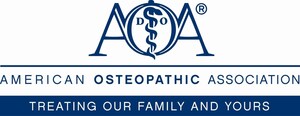Family Medicine Top Specialty for Future Osteopathic Physicians
CHICAGO, Feb. 11, 2013 /PRNewswire-USNewswire/ -- Historically, osteopathic physicians (DOs) have been committed to providing primary care. The profession's legacy will continue as family medicine remains the largest matched specialty among osteopathic medical students, according to the National Matching Services, Inc., which announced the results of the 2013 osteopathic match today.
Of the 2,512 individuals who participated in the American Osteopathic Association (AOA) Intern/Resident Registration Program, 75% of students and recent graduates successfully matched for a total of 1,891 placements.
In the last five years, six osteopathic medical schools have opened to address workforce needs in the United States and meet the demands of students who want to study osteopathic medicine, bringing the total to 26 osteopathic medical schools offering instruction in 34 locations across the United States. Today, there are more than 20,000 osteopathic medical students across the country, up from more than 15,000 students enrolled five years ago.
Among primary care specialties, family medicine saw an 11% increase and internal medicine saw a 9% increase from last year. Family medicine was the largest matched specialty with 472 positions filled. Last year family medicine also was the largest matched specialty with 433 positions filled.
"Every year, we see more and more osteopathic medical students matching into family medicine programs and other primary care specialties," said Clinton E. Adams, DO, vice chair of the AOA Council on Postdoctoral Training. "Although primary care is traditionally a lower paying specialty, the role these physicians play in educating patients about healthy lifestyle choices and disease prevention is priceless."
According to the AOA's 2012 Osteopathic Medical Profession Report, approximately half of DOs practice in the primary care areas, such as family medicine and internal medicine.
"As founding dean of the Lincoln Memorial University-DeBusk College of Osteopathic Medicine, I have been inspired by our future DOs and their dedication to practicing osteopathic medicine," said AOA President Ray E. Stowers, DO, of his experience at the Harrogate, Tenn., osteopathic medical school. "As the nation faces a looming shortage of primary care physicians, it is wonderful to see a growing number of new physicians helping to ensure patients will have access to primary care."
For more information about the 2013 osteopathic match, see full match results listed by state at www.osteopathic.org. To see osteopathic match data from previous years, see The Journal of the American Osteopathic Association at www.jaoa.org.
How the Osteopathic Match Works
Osteopathic medical students and recent graduates interview with internship and residency training programs at medical facilities around the country to determine which programs they want to pursue for their osteopathic graduate medical education. After the interview process, match participants submit a rank-order list of training programs while the programs submit a list of their preferred applicants in rank order. Using a computer program, the National Matching Services, Inc., coordinates the match of osteopathic medical students and recent graduates to internship and residency programs.
Osteopathic Match Schedule
Applicants who learn on Feb. 11 that they did not match into an internship or residency training program can participate in what is known as "the scramble" to find training positions through July of this year. An electronic post-match tool is available to assist programs and trainees who did not find placement in the match. Upon earning degrees as doctors of osteopathic medicine, graduates will begin their training programs on July 1, 2013.
What is a DO?
DOs and MDs are the only two groups of physicians fully licensed to prescribe medication and practice in all specialty areas, including surgery, in the United States. They both complete approximately four years of medical school followed by graduate medical education through internship and residency programs typically lasting three to eight years. In addition, DOs receive extra training in the musculoskeletal system, providing them with an in-depth knowledge of the ways that illness or injury in one part of the body can affect another.
About the American Osteopathic Association
The American Osteopathic Association (AOA) proudly represents its professional family of more than 100,000 osteopathic physicians (DOs) and osteopathic medical students; promotes public health; encourages scientific research; serves as the primary certifying body for DOs; is the accrediting agency for osteopathic medical schools; and has federal authority to accredit hospitals and other health care facilities. More information on DOs/osteopathic medicine can be found at www.osteopathic.org.
Twitter: @AOAforMedia
SOURCE American Osteopathic Association
WANT YOUR COMPANY'S NEWS FEATURED ON PRNEWSWIRE.COM?
Newsrooms &
Influencers
Digital Media
Outlets
Journalists
Opted In




Share this article